We began our trip by being driven to Phoenix in a limousine on Friday, June 23rd, for an overnight stay due to an early flight to NYC Saturday morning. We had champagne and truffles, so the two-hour ride went quickly. Saturday morning we left for NYC and an overnight there due to airline connections; our flight from NYC to Europe left at 6 p.m. Sunday. This was only the beginning of Dale's experiences with his harem, as we called ourselves, as two of Jane's friends had joined us on our three week trip through northern Europe. I have again included links (underlined) to some of the places we visited, so click on the links to learn more about these places; put your cursor over the photos for an explanation of what they are. 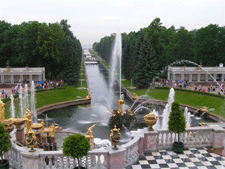 Not
all browsers will do this, but give it a try; it will work with Internet
Explorer.
Not
all browsers will do this, but give it a try; it will work with Internet
Explorer.
We arrived in Helsinki, Finland on Monday morning and boarded a flight to St. Petersburg, Russia, our home for the next four days. We were told we should not drink the tap water anywhere in the city, even our hotel, so we bought bottled water to drink in the room, brush our teeth, and fill smaller bottles to carry with us throughout our days there.
This first morning we had a tour of St. Petersburg, which
Aleksandr Pushkin called "Peter the Great's Window to the West"; it is also known as the Venice of the North, due to its more than 60 canals with hundreds of bridges. After lunch we went to
Petrodvorets to see the Summer Palace of Peter the Great, built in 1714. He asked for a Versailles by the Sea, and the czar called this magnificent summer residence, overlooking the Gulf of Finland, his cottage. The original Grand Palace was almost destroyed during WWII, but many of its treasures have been restored. There is a fountain ensemble of three waterfalls with almost 150 fountains shooting more than 2,000 jets of water among a variety of statues and sculptures. These fountains have operated for more than 250 years through 13 miles of pipes, relying on a system of gravity rather than pumps. In the evening some of us went to a Russian folk dance performance at the hotel. The performers were dressed in
Cossack costumes, and it was a very lively show. Everyone in the audience seemed to enjoy it. It was the kind of show where you get tired just watching the dancers perform.
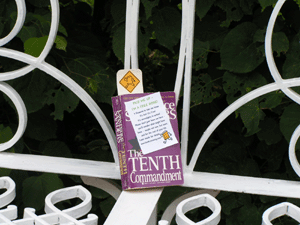 The next day we went to the town of Pushkin to see Catherine's Summer Palace
which contains the famous Amber Room. The Palace was built for Peter the Great
and expanded by his daughter Elizabeth. For the Bookcrossers reading this,
here's a photo proving that even Ballycumber made the trip. I released books
into the wild all over northern Europe. This is a book I received from BCer
"Firegirl" in a book trade. The Palace was burned to the ground in the WWII siege of St. Petersburg, and the building standing today is said to be the finest replica in the world. Walking through the gates and up the long entrance to the palace was almost surreal, with the huge palace at the end of the walkway. In the afternoon we toured the
Hermitage Museum, which served as the Winter Palace and home of the Czars. There are more than 1,000 rooms housing nearly three million exhibits containing the works of some of the greatest artists of the world including Michelangelo, da Vinci, Raphael, Rembrandt, many French Impressionists, Van Gogh, Rodin and others. To see everything, one would have to spend days upon days, and we had only a short introduction to this massive collection.
The next day we went to the town of Pushkin to see Catherine's Summer Palace
which contains the famous Amber Room. The Palace was built for Peter the Great
and expanded by his daughter Elizabeth. For the Bookcrossers reading this,
here's a photo proving that even Ballycumber made the trip. I released books
into the wild all over northern Europe. This is a book I received from BCer
"Firegirl" in a book trade. The Palace was burned to the ground in the WWII siege of St. Petersburg, and the building standing today is said to be the finest replica in the world. Walking through the gates and up the long entrance to the palace was almost surreal, with the huge palace at the end of the walkway. In the afternoon we toured the
Hermitage Museum, which served as the Winter Palace and home of the Czars. There are more than 1,000 rooms housing nearly three million exhibits containing the works of some of the greatest artists of the world including Michelangelo, da Vinci, Raphael, Rembrandt, many French Impressionists, Van Gogh, Rodin and others. To see everything, one would have to spend days upon days, and we had only a short introduction to this massive collection.
On our last day in St. Petersburg we toured the Yusupov Palace where Prince Yusupov murdered Rasputin,
the Mad Monk, in 1916. We saw rooms that have been restored and felt eerily like
it could have been the night of the murder. The palace is owned today by one of
the wealthiest families in Russia, and we saw and sat in its theater for live
stage plays. We viewed the dining room where Rasputin was said to have been
murdered, and there were wax figures seated and standing that looked so real we
expected them to move. In the afternoon we toured the Peter and Paul Fortress, the chief monument to Peter the Great's reign, and Saint Isaac's Cathedral, which has a beautiful spire topped by a golden angel holding a cross. Recently the remains of the last Romanov family (Nicholas, Alexandra and their children) were moved and buried here. 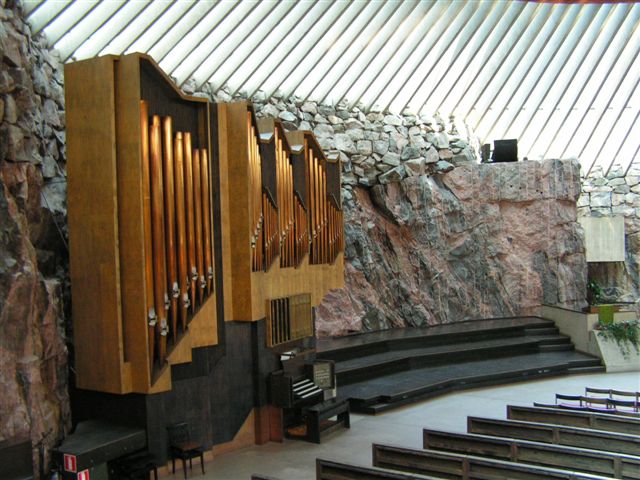 After these tours, we cruised the Neva River and the city's canals. There were no bridges across the river when the city was founded, and today there are more than 500 bridges connecting the city's banks and its 101 islands. There were two boys, probably junior high age, who ran from bridge to bridge as our canal boat cruised along. They would stand on the bridge and wave as we passed under them. Of course, at the end of our cruise they were waiting for a tip as we got off our boat. Dinner this evening was with a Russian family in their dacha country home. We were able to ask questions of the family after dinner and learn about their life. Entertainment was provided by a small ensemble that did Russian dances, sang, and played instruments. The next day was a travel day, as we would leave for Helsinki, Finland.
After these tours, we cruised the Neva River and the city's canals. There were no bridges across the river when the city was founded, and today there are more than 500 bridges connecting the city's banks and its 101 islands. There were two boys, probably junior high age, who ran from bridge to bridge as our canal boat cruised along. They would stand on the bridge and wave as we passed under them. Of course, at the end of our cruise they were waiting for a tip as we got off our boat. Dinner this evening was with a Russian family in their dacha country home. We were able to ask questions of the family after dinner and learn about their life. Entertainment was provided by a small ensemble that did Russian dances, sang, and played instruments. The next day was a travel day, as we would leave for Helsinki, Finland.
At dinner our first evening in Helsinki we renewed acquaintances with a couple we had met the previous year on our Rhine and Mosel trip. This isn't the first time we've had this type of surprise. At a restaurant in Paris three years ago we saw a couple we'd met a couple of years earlier on a riverboat trip. The next morning we had a tour of Helsinki, including
Senate Square, the Sibelius Monument and the outdoor fish market. We also saw the Temppeliaukion Kirkko Church, a church that is built into solid granite and is mostly underground. The sea is an integral part of this city, as Helsinki spreads out onto islands, peninsulas, and along coves between which all descriptions of boats navigate.
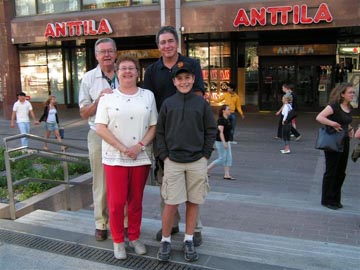 In the afternoon Dale's son David, wife Heather and their son Eliel, vacationing from Northern California, met us at our hotel and we walked to the fish market for lunch and a look around. Eliel bought Jane one of her favorites, a Magnum ice cream bar, the best ever made! Ooooh, double chocolate caramel ... yummy! We wandered around for a while after lunch, and then, since they had a car, we drove to the little town of Porvoo, the second oldest town in Finland. Its sidewalks and streets are cobblestone, and there's a river running along the edge of the town.
In the afternoon Dale's son David, wife Heather and their son Eliel, vacationing from Northern California, met us at our hotel and we walked to the fish market for lunch and a look around. Eliel bought Jane one of her favorites, a Magnum ice cream bar, the best ever made! Ooooh, double chocolate caramel ... yummy! We wandered around for a while after lunch, and then, since they had a car, we drove to the little town of Porvoo, the second oldest town in Finland. Its sidewalks and streets are cobblestone, and there's a river running along the edge of the town. 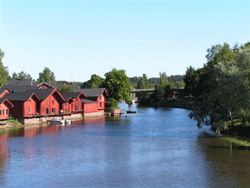 It was a very relaxing afternoon. We returned to Helsinki for dinner at a restaurant owned by a man from northern Finland, who, we discovered, knew a relative of Dale's who owns a resort north of the Arctic Circle. We toured the
Soumenlinna Island Fortress the next morning. It is 250 years old and the largest maritime fortress in the world. It houses seven museums, cafes, a marina, and of course, a gift shop. This fortress is home to the Finnish Naval Academy.
It was a very relaxing afternoon. We returned to Helsinki for dinner at a restaurant owned by a man from northern Finland, who, we discovered, knew a relative of Dale's who owns a resort north of the Arctic Circle. We toured the
Soumenlinna Island Fortress the next morning. It is 250 years old and the largest maritime fortress in the world. It houses seven museums, cafes, a marina, and of course, a gift shop. This fortress is home to the Finnish Naval Academy.
In the afternoon we flew to Copenhagen where we would spend the next three days. We heard a lecture on the literary works of
Hans Christian Anderson, who wrote The Little Mermaid, The Ugly Duckling, and 166 other classic children's tales. On our city tour the next morning we saw The Little Mermaid statue in the harbor. She is life-size, not an oversized statue as many people think. We were surprised she was as small as she is. We also saw the changing of the palace guard, an impressive ceremony that is timed to the second. After the tour we stayed in town and shopped at the Royal Copenhagen outlet, had lunch, and walked the shopping streets. In the evening we took a city bus to Tivoli Gardens,  where we walked around, relaxed and had dinner in one of the many restaurants before catching a cab back to the hotel. The next day was, as I call it, Free Day at Camp. Dale decided to relax around the hotel, and the three of us in his harem walked downtown to shop and have lunch. There are bicycle riders all over Copenhagen, due to the lack of parking space for cars. Many residents own two bikes, one they ride to the bus stop and leave there; the second bike is left at the other end of their bus line for riding to work. In the evening we had a wonderful dinner in a local home and learned about Danish life from our host and hostess. A typical work day is 7 1/2 hours and workers get at least five weeks of vacation a year. Education and health care are state funded, and the Danish live a relaxed lifestyle compared to other countries.
where we walked around, relaxed and had dinner in one of the many restaurants before catching a cab back to the hotel. The next day was, as I call it, Free Day at Camp. Dale decided to relax around the hotel, and the three of us in his harem walked downtown to shop and have lunch. There are bicycle riders all over Copenhagen, due to the lack of parking space for cars. Many residents own two bikes, one they ride to the bus stop and leave there; the second bike is left at the other end of their bus line for riding to work. In the evening we had a wonderful dinner in a local home and learned about Danish life from our host and hostess. A typical work day is 7 1/2 hours and workers get at least five weeks of vacation a year. Education and health care are state funded, and the Danish live a relaxed lifestyle compared to other countries.
The next morning we rode through the Danish countryside past forests and lakes and palatial homes, including the home of Karen Blixen (Isak Dinesen), who wrote Out of Africa, on our way to Elsinore and the Kronborg Castle. The castle was built on the cliffs of Elsinore above the Baltic shore, and according to legend, was the home of Hamlet, Shakespeare's melancholy Prince of Denmark. We walked through the courtyard and had a guided tour of the interior. 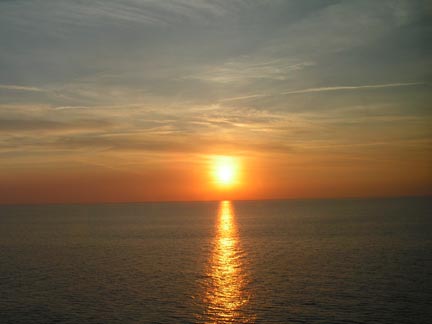 We then rode a bit further north along the coastline to the little fishing village of Gilleleje, where in 1943 nearly all of Denmark's Jewish population was evacuated to Sweden. We had Danish fish cakes for lunch at the harbor before returning to Copenhagen, where we would board our ship for dinner and an overnight cruise across the North Sea to Oslo, Norway. The photo on the right was taken by Jane from our cruise ship cabin at 9:45 p.m. This trip had daylight hours similar to Alaska in the summer where it is light until very late at night, and the sun rises very early in the morning.
We then rode a bit further north along the coastline to the little fishing village of Gilleleje, where in 1943 nearly all of Denmark's Jewish population was evacuated to Sweden. We had Danish fish cakes for lunch at the harbor before returning to Copenhagen, where we would board our ship for dinner and an overnight cruise across the North Sea to Oslo, Norway. The photo on the right was taken by Jane from our cruise ship cabin at 9:45 p.m. This trip had daylight hours similar to Alaska in the summer where it is light until very late at night, and the sun rises very early in the morning.
We arrived in Oslo shortly after breakfast and had a tour of the city, which has nature at its doorstep - fields, forests, fjords, farms, mountains and meadows all within the city limits. We visited Oslo's
Vigeland Sculpture Park. This is an amazing 80-acre sculpture park with the collection of 192 granite and bronze sculptures. Gustav Vigeland's life-size nude bronze and granite statues depict all phases and ages of life. This was his life's work and began in 1921 and continued until after World War II. The park is funded by the people of Oslo, is open to all and there is no entrance fee. You can wander the gardens and sculptures at leisure and stay as long as you want. The website above shows some of the sculptures, though pictures cannot possibly show the details of these magnificent works of art. On the way to our hotel we saw the 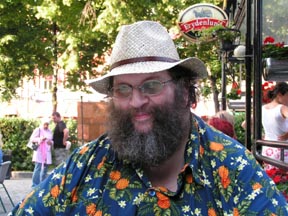 Royal Palace and the Town Hall, where the Nobel Peace prizes are presented each year on December 10th. Upon arrival at our hotel we had a phone message from Jane's cousin, Lars, with whom we would have dinner the next evening. We've been e-mailing and exchanging calendars for several years, and were to finally meet. We send him an Arizona Highways calendar each year, and he sends us a Bergen calendar. After settling into our hotel we had a walking tour of the area so we could later find the shopping areas and restaurants. One of our stops was the National Gallery, which devotes two rooms to Edvard Munch and features one of the four originals of The Scream.
Royal Palace and the Town Hall, where the Nobel Peace prizes are presented each year on December 10th. Upon arrival at our hotel we had a phone message from Jane's cousin, Lars, with whom we would have dinner the next evening. We've been e-mailing and exchanging calendars for several years, and were to finally meet. We send him an Arizona Highways calendar each year, and he sends us a Bergen calendar. After settling into our hotel we had a walking tour of the area so we could later find the shopping areas and restaurants. One of our stops was the National Gallery, which devotes two rooms to Edvard Munch and features one of the four originals of The Scream.
In the morning we had more Free Time at Camp, so relaxed a little and walked up Karl Johann Gate, the shopping street near our hotel. In the afternoon we went to the Bygdoy Peninsula, which is on beautiful Oslo Fjord. After viewing a film on Viking history, we toured the
Viking Ship Museum, which contains three Viking longboats dating to A.D. 800, plus artifacts found on sunken or buried ships around the Oslo Fjord. Some of these artifacts are carved sledges, wagons, textiles, harnesses, tools and kitchen utensils. From there we went to the
Kon Tiki Museum where we saw the balsa raft Kon Tiki, built in 1947 and used by Thor Heyerdahl, and the RAII built in 1970. It's amazing to think that Thor Heyerdahl traveled so far on these small rafts. After this museum, we went to the
Nobel Peace Center where we had an opportunity to listen to videos of the acceptance speeches given by recipients and to see the amazing photos taken from all over the world. It's a very impressive venue. All in all, it was another very full but educational day.
 We left the next morning on our "Norway in a Nutshell" tour, traveling by train, ferry, boat and motorcoach, stopping in
Eidsfjord, where we would spend the night. Upon our arrival, we left to visit a working mountain sheep farm, which in Norwegian is a Fjellgaarden. To get to the farm we went by motorcoach through a one-way tunnel for which reservations are required; if you miss your reserved time, you cannot enter the tunnel lest you meet a vehicle coming through from the other direction. We had a leisurely dinner at the hotel and played cards with some of our fellow travelers before retiring for the night. Amazingly, the Queen Mary cruise ship docks at this hotel on a fjord that is miles and miles from the sea. On our journey the next day we rode through the mountains and along the fjords, stopping at the scenic
Kjosfossen waterfall, one of the most beautiful waterfalls we have ever seen. One thing I neglected to mention is that fjords are as deep as the cliffs are tall above the water. Our motorcoach had to stop for a Norwegian traffic jam - a herd of goats were crossing the road. In New Zealand we had a similar experience, having to stop to let a herd of sheep cross the highway. There is a photo of this on our Australia/New Zealand site. In the late afternoon, after a city tour,
We left the next morning on our "Norway in a Nutshell" tour, traveling by train, ferry, boat and motorcoach, stopping in
Eidsfjord, where we would spend the night. Upon our arrival, we left to visit a working mountain sheep farm, which in Norwegian is a Fjellgaarden. To get to the farm we went by motorcoach through a one-way tunnel for which reservations are required; if you miss your reserved time, you cannot enter the tunnel lest you meet a vehicle coming through from the other direction. We had a leisurely dinner at the hotel and played cards with some of our fellow travelers before retiring for the night. Amazingly, the Queen Mary cruise ship docks at this hotel on a fjord that is miles and miles from the sea. On our journey the next day we rode through the mountains and along the fjords, stopping at the scenic
Kjosfossen waterfall, one of the most beautiful waterfalls we have ever seen. One thing I neglected to mention is that fjords are as deep as the cliffs are tall above the water. Our motorcoach had to stop for a Norwegian traffic jam - a herd of goats were crossing the road. In New Zealand we had a similar experience, having to stop to let a herd of sheep cross the highway. There is a photo of this on our Australia/New Zealand site. In the late afternoon, after a city tour,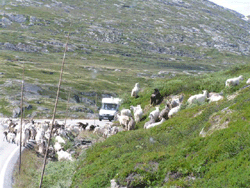 we arrived at our hotel in Bergen, our home for the next couple of days. We had a vicinity walk around our hotel area (in the rain) through the
Hanseatic housing area and to the fish market.
we arrived at our hotel in Bergen, our home for the next couple of days. We had a vicinity walk around our hotel area (in the rain) through the
Hanseatic housing area and to the fish market.
We chose to spend the next day on our own and not go on a tour that was offered. After breakfast at the hotel we walked to the harbor, the shopping area near the hotel and the fish market, where we stopped for a delicious lunch of fish. We each chose the piece of fish we wanted, then watched as it was cooked. After lunch we walked around this historical and interesting town and discovered the
Mariakirken (St. Mary's Church). It has a beautiful interior and a one-of-a-kind Baroque pulpit. For dinner this evening we went with seven others from our tour group to a restaurant near the harbor that serves whale steak. Jane tried it, as did some of the others, figuring it would be our only opportunity for this experience. The meat looked and tasted similar to beef.
The next morning we flew to Stockholm, Sweden. We had the usual vicinity walk around our hotel area so we would be familiar with what was available. Stockholm is a beautiful city spread across 14 islands, and surrounded by 24,000 more. The weather couldn't have been better  for sightseeing and walking around. Jane made reservations for eight of us at the Ice Bar for the next afternoon. More on this later. After breakfast the following morning we enjoyed a city tour. Stockholm was originally built as a fortress around the year 1250. We saw the Royal Palace, which is the center of the city and the nation. We also saw the Ridderholm Church built in the 13th century, and the Swedish Pantheon, which has been the burial place of Swedish kings for four centuries. We visited
City Hall, which is built of eight million red bricks and overlooks Lake Malaren. We saw the glittering Golden Hall with its 18 million-piece mosaics of glass and gold, and the Blue Hall, home to the largest pipe organ in Scandinavia, and perhaps best known as the dining hall used for the banquet held after the annual Nobel Prize award ceremony. We ascended the Grand Staircase and walked the reverse route by which the dignitaries enter this hall for the Nobel Prize banquets. After this morning-long tour we went to a local restaurant for a demonstration (and tasting) of various ways to prepare herring. This was different than the herring we get in the States, as it was prepared and served fresh. Lunch consisted of Swedish meatballs, mashed potatoes and gravy. A group of Swedish college students joined us for lunch, and it was interesting to visit with them. One thing we learned is English is a required subject starting in second grade, and these students were fluent in our language.
for sightseeing and walking around. Jane made reservations for eight of us at the Ice Bar for the next afternoon. More on this later. After breakfast the following morning we enjoyed a city tour. Stockholm was originally built as a fortress around the year 1250. We saw the Royal Palace, which is the center of the city and the nation. We also saw the Ridderholm Church built in the 13th century, and the Swedish Pantheon, which has been the burial place of Swedish kings for four centuries. We visited
City Hall, which is built of eight million red bricks and overlooks Lake Malaren. We saw the glittering Golden Hall with its 18 million-piece mosaics of glass and gold, and the Blue Hall, home to the largest pipe organ in Scandinavia, and perhaps best known as the dining hall used for the banquet held after the annual Nobel Prize award ceremony. We ascended the Grand Staircase and walked the reverse route by which the dignitaries enter this hall for the Nobel Prize banquets. After this morning-long tour we went to a local restaurant for a demonstration (and tasting) of various ways to prepare herring. This was different than the herring we get in the States, as it was prepared and served fresh. Lunch consisted of Swedish meatballs, mashed potatoes and gravy. A group of Swedish college students joined us for lunch, and it was interesting to visit with them. One thing we learned is English is a required subject starting in second grade, and these students were fluent in our language.
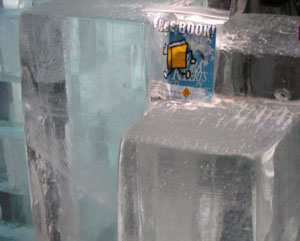 In the afternoon eight from our tour group walked to the Ice Bar. This bar is inside a hotel and is built of blocks of ice, like an igloo. The drinking glasses are made of
molded ice (you can keep it as a souvenir ... haha ... some of us left our glass in a planter outside the hotel). Upon arrival, patrons are issued a parka with gloves attached. This reminded Jane of when she was a child and her winter gloves were pinned to her jacket so she wouldn't lose them. Click on the link above for more information about the Ice Bar. This is, to say the least, something one needs to do if in Stockholm. Jane released another Bookcrossing book here, leaving Nora Robert's Born in Ice
sitting on a bar stool made of a huge block of ice. On our last day in Stockholm
we had a tour of the Vasa Museum. The warship Vasa was named for King Gustav I and capsized in the harbor on her very short maiden voyage in 1628. Poor design (she was top-heavy) caused her to roll and sink almost immediately upon leaving the dock. The cold harbor waters preserved her and she was salvaged in 1961. She is now the only intact and well preserved 17th century warship in the world. There is a menu from the 17th century that is very interesting, as well as current menus.
In the afternoon eight from our tour group walked to the Ice Bar. This bar is inside a hotel and is built of blocks of ice, like an igloo. The drinking glasses are made of
molded ice (you can keep it as a souvenir ... haha ... some of us left our glass in a planter outside the hotel). Upon arrival, patrons are issued a parka with gloves attached. This reminded Jane of when she was a child and her winter gloves were pinned to her jacket so she wouldn't lose them. Click on the link above for more information about the Ice Bar. This is, to say the least, something one needs to do if in Stockholm. Jane released another Bookcrossing book here, leaving Nora Robert's Born in Ice
sitting on a bar stool made of a huge block of ice. On our last day in Stockholm
we had a tour of the Vasa Museum. The warship Vasa was named for King Gustav I and capsized in the harbor on her very short maiden voyage in 1628. Poor design (she was top-heavy) caused her to roll and sink almost immediately upon leaving the dock. The cold harbor waters preserved her and she was salvaged in 1961. She is now the only intact and well preserved 17th century warship in the world. There is a menu from the 17th century that is very interesting, as well as current menus.
We then visited Skansen, the first open-air museum in the world, located on the island of
Djurgården, a royal park near Stockholm center. It is both an historical park featuring 150 buildings moved from all over Sweden, and a zoological park that focuses on Scandinavian fauna. After our tour we had lunch at one of the museum's restaurants. In the evening our tour group's farewell dinner was in the City Hall Cellar Restaurant, former site of Nobel Prize banquets. This restaurant is literally in the cellar of Stockholm's magnificent City Hall. Our meal was prepared by one of the former chefs of the Nobel Prize dinners.
Below is a list of "Proverbs" that Craig Waith, our Program Director through Helsinki, Copenhagen and Scandinavia kept repeating throughout our trip. Thanks to Sharon for having the foresight to compile this list throughout the trip, for reading it to us at our farewell dinner in Stockholm, and for sending it to me for this website. When Craig talked, the whole airport (or restaurant, or street corner, or city ....) heard him. We had no trouble finding him, since his voice carried over any other sounds wherever we were.
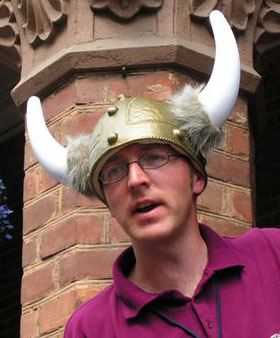
"It's eeeeasy!"
"There is no right or wrong, just different."
"If you leave my papers on the bus, I'll cry."
"Turn left at the horrible green chairs." (Stockholm)
"Your luggage is getting heavier and heavier."
"I'll be the one flapping and waving my arms."
"I'm the one in the Viking hat." (Oslo)
"You can't get lost."
"Hold your thumbs." (The Scandinavian equivalent of crossing your fingers)
"There's a difference between needs and wants."
"Its already written on the board."
"Sit back, relax and listen to Songs from the Secret Garden." (Riding across Norway from Oslo to Bergen)
"When I say 9:25, I mean 9:25, not 9:30."
"The last person on the bus buys drinks for everyone."
"Rotate seats around the bus."
"The women go to the men's restroom."
"Bad news: there is no air conditioning in the hotel."
"There is no bad weather; just bad clothing."
Our next trip is Eastern Europe to the Black Sea, beginning with five days in Prague, Czech Republic, then Budapest followed by eight days on a riverboat to Constanta on the Black Sea, ending with four days in Bucharest and Transylvania. I plan to release Bookcrossing books about vampires when we're in Transylvania.
 After these tours, we cruised the Neva River and the city's canals. There were no bridges across the river when the city was founded, and today there are more than 500 bridges connecting the city's banks and its 101 islands. There were two boys, probably junior high age, who ran from bridge to bridge as our canal boat cruised along. They would stand on the bridge and wave as we passed under them. Of course, at the end of our cruise they were waiting for a tip as we got off our boat. Dinner this evening was with a Russian family in their dacha country home. We were able to ask questions of the family after dinner and learn about their life. Entertainment was provided by a small ensemble that did Russian dances, sang, and played instruments. The next day was a travel day, as we would leave for Helsinki, Finland.
After these tours, we cruised the Neva River and the city's canals. There were no bridges across the river when the city was founded, and today there are more than 500 bridges connecting the city's banks and its 101 islands. There were two boys, probably junior high age, who ran from bridge to bridge as our canal boat cruised along. They would stand on the bridge and wave as we passed under them. Of course, at the end of our cruise they were waiting for a tip as we got off our boat. Dinner this evening was with a Russian family in their dacha country home. We were able to ask questions of the family after dinner and learn about their life. Entertainment was provided by a small ensemble that did Russian dances, sang, and played instruments. The next day was a travel day, as we would leave for Helsinki, Finland. Not
all browsers will do this, but give it a try; it will work with Internet
Explorer.
Not
all browsers will do this, but give it a try; it will work with Internet
Explorer.
 The next day we went to the town of Pushkin to see Catherine's Summer Palace
which contains the famous Amber Room. The Palace was built for Peter the Great
and expanded by his daughter Elizabeth. For the Bookcrossers reading this,
here's a photo proving that even Ballycumber made the trip. I released books
into the wild all over northern Europe. This is a book I received from BCer
"Firegirl" in a book trade. The Palace was burned to the ground in the WWII siege of St. Petersburg, and the building standing today is said to be the finest replica in the world. Walking through the gates and up the long entrance to the palace was almost surreal, with the huge palace at the end of the walkway. In the afternoon we toured the
Hermitage Museum, which served as the Winter Palace and home of the Czars. There are more than 1,000 rooms housing nearly three million exhibits containing the works of some of the greatest artists of the world including Michelangelo, da Vinci, Raphael, Rembrandt, many French Impressionists, Van Gogh, Rodin and others. To see everything, one would have to spend days upon days, and we had only a short introduction to this massive collection.
The next day we went to the town of Pushkin to see Catherine's Summer Palace
which contains the famous Amber Room. The Palace was built for Peter the Great
and expanded by his daughter Elizabeth. For the Bookcrossers reading this,
here's a photo proving that even Ballycumber made the trip. I released books
into the wild all over northern Europe. This is a book I received from BCer
"Firegirl" in a book trade. The Palace was burned to the ground in the WWII siege of St. Petersburg, and the building standing today is said to be the finest replica in the world. Walking through the gates and up the long entrance to the palace was almost surreal, with the huge palace at the end of the walkway. In the afternoon we toured the
Hermitage Museum, which served as the Winter Palace and home of the Czars. There are more than 1,000 rooms housing nearly three million exhibits containing the works of some of the greatest artists of the world including Michelangelo, da Vinci, Raphael, Rembrandt, many French Impressionists, Van Gogh, Rodin and others. To see everything, one would have to spend days upon days, and we had only a short introduction to this massive collection. In the afternoon Dale's son David, wife Heather and their son Eliel, vacationing from Northern California, met us at our hotel and we walked to the fish market for lunch and a look around. Eliel bought Jane one of her favorites, a Magnum ice cream bar, the best ever made! Ooooh, double chocolate caramel ... yummy! We wandered around for a while after lunch, and then, since they had a car, we drove to the little town of
In the afternoon Dale's son David, wife Heather and their son Eliel, vacationing from Northern California, met us at our hotel and we walked to the fish market for lunch and a look around. Eliel bought Jane one of her favorites, a Magnum ice cream bar, the best ever made! Ooooh, double chocolate caramel ... yummy! We wandered around for a while after lunch, and then, since they had a car, we drove to the little town of  It was a very relaxing afternoon. We returned to Helsinki for dinner at a restaurant owned by a man from northern Finland, who, we discovered, knew a relative of Dale's who owns a resort north of the Arctic Circle. We toured the
Soumenlinna Island Fortress the next morning. It is 250 years old and the largest maritime fortress in the world. It houses seven museums, cafes, a marina, and of course, a gift shop. This fortress is home to the Finnish Naval Academy.
It was a very relaxing afternoon. We returned to Helsinki for dinner at a restaurant owned by a man from northern Finland, who, we discovered, knew a relative of Dale's who owns a resort north of the Arctic Circle. We toured the
Soumenlinna Island Fortress the next morning. It is 250 years old and the largest maritime fortress in the world. It houses seven museums, cafes, a marina, and of course, a gift shop. This fortress is home to the Finnish Naval Academy. where we walked around, relaxed and had dinner in one of the many restaurants before catching a cab back to the hotel. The next day was, as I call it, Free Day at Camp. Dale decided to relax around the hotel, and the three of us in his harem walked downtown to shop and have lunch. There are bicycle riders all over Copenhagen, due to the lack of parking space for cars. Many residents own two bikes, one they ride to the bus stop and leave there; the second bike is left at the other end of their bus line for riding to work. In the evening we had a wonderful dinner in a local home and learned about Danish life from our host and hostess. A typical work day is 7 1/2 hours and workers get at least five weeks of vacation a year. Education and health care are state funded, and the Danish live a relaxed lifestyle compared to other countries.
where we walked around, relaxed and had dinner in one of the many restaurants before catching a cab back to the hotel. The next day was, as I call it, Free Day at Camp. Dale decided to relax around the hotel, and the three of us in his harem walked downtown to shop and have lunch. There are bicycle riders all over Copenhagen, due to the lack of parking space for cars. Many residents own two bikes, one they ride to the bus stop and leave there; the second bike is left at the other end of their bus line for riding to work. In the evening we had a wonderful dinner in a local home and learned about Danish life from our host and hostess. A typical work day is 7 1/2 hours and workers get at least five weeks of vacation a year. Education and health care are state funded, and the Danish live a relaxed lifestyle compared to other countries.  We then rode a bit further north along the coastline to the little fishing village of Gilleleje, where in 1943 nearly all of Denmark's Jewish population was evacuated to Sweden. We had Danish fish cakes for lunch at the harbor before returning to Copenhagen, where we would board our ship for dinner and an overnight cruise across the North Sea to Oslo, Norway. The photo on the right was taken by Jane from our cruise ship cabin at 9:45 p.m. This trip had daylight hours similar to Alaska in the summer where it is light until very late at night, and the sun rises very early in the morning.
We then rode a bit further north along the coastline to the little fishing village of Gilleleje, where in 1943 nearly all of Denmark's Jewish population was evacuated to Sweden. We had Danish fish cakes for lunch at the harbor before returning to Copenhagen, where we would board our ship for dinner and an overnight cruise across the North Sea to Oslo, Norway. The photo on the right was taken by Jane from our cruise ship cabin at 9:45 p.m. This trip had daylight hours similar to Alaska in the summer where it is light until very late at night, and the sun rises very early in the morning. Royal Palace and the Town Hall, where the Nobel Peace prizes are presented each year on December 10th. Upon arrival at our hotel we had a phone message from Jane's cousin, Lars, with whom we would have dinner the next evening. We've been e-mailing and exchanging calendars for several years, and were to finally meet. We send him an Arizona Highways calendar each year, and he sends us a Bergen calendar. After settling into our hotel we had a walking tour of the area so we could later find the shopping areas and restaurants. One of our stops was the National Gallery, which devotes two rooms to Edvard Munch and features one of the four originals of The Scream.
Royal Palace and the Town Hall, where the Nobel Peace prizes are presented each year on December 10th. Upon arrival at our hotel we had a phone message from Jane's cousin, Lars, with whom we would have dinner the next evening. We've been e-mailing and exchanging calendars for several years, and were to finally meet. We send him an Arizona Highways calendar each year, and he sends us a Bergen calendar. After settling into our hotel we had a walking tour of the area so we could later find the shopping areas and restaurants. One of our stops was the National Gallery, which devotes two rooms to Edvard Munch and features one of the four originals of The Scream.  We left the next morning on our "Norway in a Nutshell" tour, traveling by train, ferry, boat and motorcoach, stopping in
Eidsfjord, where we would spend the night. Upon our arrival, we left to visit a working mountain sheep farm, which in Norwegian is a Fjellgaarden. To get to the farm we went by motorcoach through a one-way tunnel for which reservations are required; if you miss your reserved time, you cannot enter the tunnel lest you meet a vehicle coming through from the other direction. We had a leisurely dinner at the hotel and played cards with some of our fellow travelers before retiring for the night. Amazingly, the Queen Mary cruise ship docks at this hotel on a fjord that is miles and miles from the sea. On our journey the next day we rode
We left the next morning on our "Norway in a Nutshell" tour, traveling by train, ferry, boat and motorcoach, stopping in
Eidsfjord, where we would spend the night. Upon our arrival, we left to visit a working mountain sheep farm, which in Norwegian is a Fjellgaarden. To get to the farm we went by motorcoach through a one-way tunnel for which reservations are required; if you miss your reserved time, you cannot enter the tunnel lest you meet a vehicle coming through from the other direction. We had a leisurely dinner at the hotel and played cards with some of our fellow travelers before retiring for the night. Amazingly, the Queen Mary cruise ship docks at this hotel on a fjord that is miles and miles from the sea. On our journey the next day we rode  we arrived at our hotel in Bergen, our home for the next couple of days. We had a vicinity walk around our hotel area (in the rain) through the
Hanseatic housing area and to the fish market.
we arrived at our hotel in Bergen, our home for the next couple of days. We had a vicinity walk around our hotel area (in the rain) through the
Hanseatic housing area and to the fish market. for sightseeing and walking around. Jane made reservations for eight of us at the Ice Bar for the next afternoon. More on this later. After breakfast the following morning we enjoyed a city tour. Stockholm was originally built as a fortress around the year 1250. We saw the Royal Palace, which is the center of the city and the nation. We also saw the Ridderholm Church built in the 13th century, and the Swedish Pantheon, which has been the burial place of Swedish kings for four centuries. We visited
City Hall, which is built of eight million red bricks and overlooks Lake Malaren. We saw the glittering Golden Hall with its 18 million-piece mosaics of glass and gold, and the Blue Hall, home to the largest pipe organ in Scandinavia, and perhaps best known as the dining hall used for the banquet held after the annual Nobel Prize award ceremony. We ascended the Grand Staircase and walked the reverse route by which the dignitaries enter this hall for the Nobel Prize banquets. After this morning-long tour we went to a local restaurant for a demonstration (and tasting) of various ways to prepare herring. This was different than the herring we get in the States, as it was prepared and served fresh. Lunch consisted of Swedish meatballs, mashed potatoes and gravy. A group of Swedish college students joined us for lunch, and it was interesting to visit with them. One thing we learned is English is a required subject starting in second grade, and these students were fluent in our language.
for sightseeing and walking around. Jane made reservations for eight of us at the Ice Bar for the next afternoon. More on this later. After breakfast the following morning we enjoyed a city tour. Stockholm was originally built as a fortress around the year 1250. We saw the Royal Palace, which is the center of the city and the nation. We also saw the Ridderholm Church built in the 13th century, and the Swedish Pantheon, which has been the burial place of Swedish kings for four centuries. We visited
City Hall, which is built of eight million red bricks and overlooks Lake Malaren. We saw the glittering Golden Hall with its 18 million-piece mosaics of glass and gold, and the Blue Hall, home to the largest pipe organ in Scandinavia, and perhaps best known as the dining hall used for the banquet held after the annual Nobel Prize award ceremony. We ascended the Grand Staircase and walked the reverse route by which the dignitaries enter this hall for the Nobel Prize banquets. After this morning-long tour we went to a local restaurant for a demonstration (and tasting) of various ways to prepare herring. This was different than the herring we get in the States, as it was prepared and served fresh. Lunch consisted of Swedish meatballs, mashed potatoes and gravy. A group of Swedish college students joined us for lunch, and it was interesting to visit with them. One thing we learned is English is a required subject starting in second grade, and these students were fluent in our language.
 In the afternoon eight from our tour group walked to the Ice Bar. This bar is inside a hotel and is built of blocks of ice, like an igloo. The drinking glasses are made of
molded ice (you can keep it as a souvenir ... haha ... some of us left our glass in a planter outside the hotel). Upon arrival, patrons are issued a parka with gloves attached. This reminded Jane of when she was a child and her winter gloves were pinned to her jacket so she wouldn't lose them. Click on the link above for more information about the Ice Bar. This is, to say the least, something one needs to do if in Stockholm. Jane released another Bookcrossing book here, leaving Nora Robert's Born in Ice
sitting on a bar stool made of a huge block of ice. On our last day in Stockholm
we had a tour of the Vasa Museum. The warship Vasa was named for King Gustav I and capsized in the harbor on her very short maiden voyage in 1628. Poor design (she was top-heavy) caused her to roll and sink almost immediately upon leaving the dock. The cold harbor waters preserved her and she was salvaged in 1961. She is now the only intact and well preserved 17th century warship in the world. There is a menu from the 17th century that is very interesting, as well as current menus.
In the afternoon eight from our tour group walked to the Ice Bar. This bar is inside a hotel and is built of blocks of ice, like an igloo. The drinking glasses are made of
molded ice (you can keep it as a souvenir ... haha ... some of us left our glass in a planter outside the hotel). Upon arrival, patrons are issued a parka with gloves attached. This reminded Jane of when she was a child and her winter gloves were pinned to her jacket so she wouldn't lose them. Click on the link above for more information about the Ice Bar. This is, to say the least, something one needs to do if in Stockholm. Jane released another Bookcrossing book here, leaving Nora Robert's Born in Ice
sitting on a bar stool made of a huge block of ice. On our last day in Stockholm
we had a tour of the Vasa Museum. The warship Vasa was named for King Gustav I and capsized in the harbor on her very short maiden voyage in 1628. Poor design (she was top-heavy) caused her to roll and sink almost immediately upon leaving the dock. The cold harbor waters preserved her and she was salvaged in 1961. She is now the only intact and well preserved 17th century warship in the world. There is a menu from the 17th century that is very interesting, as well as current menus.